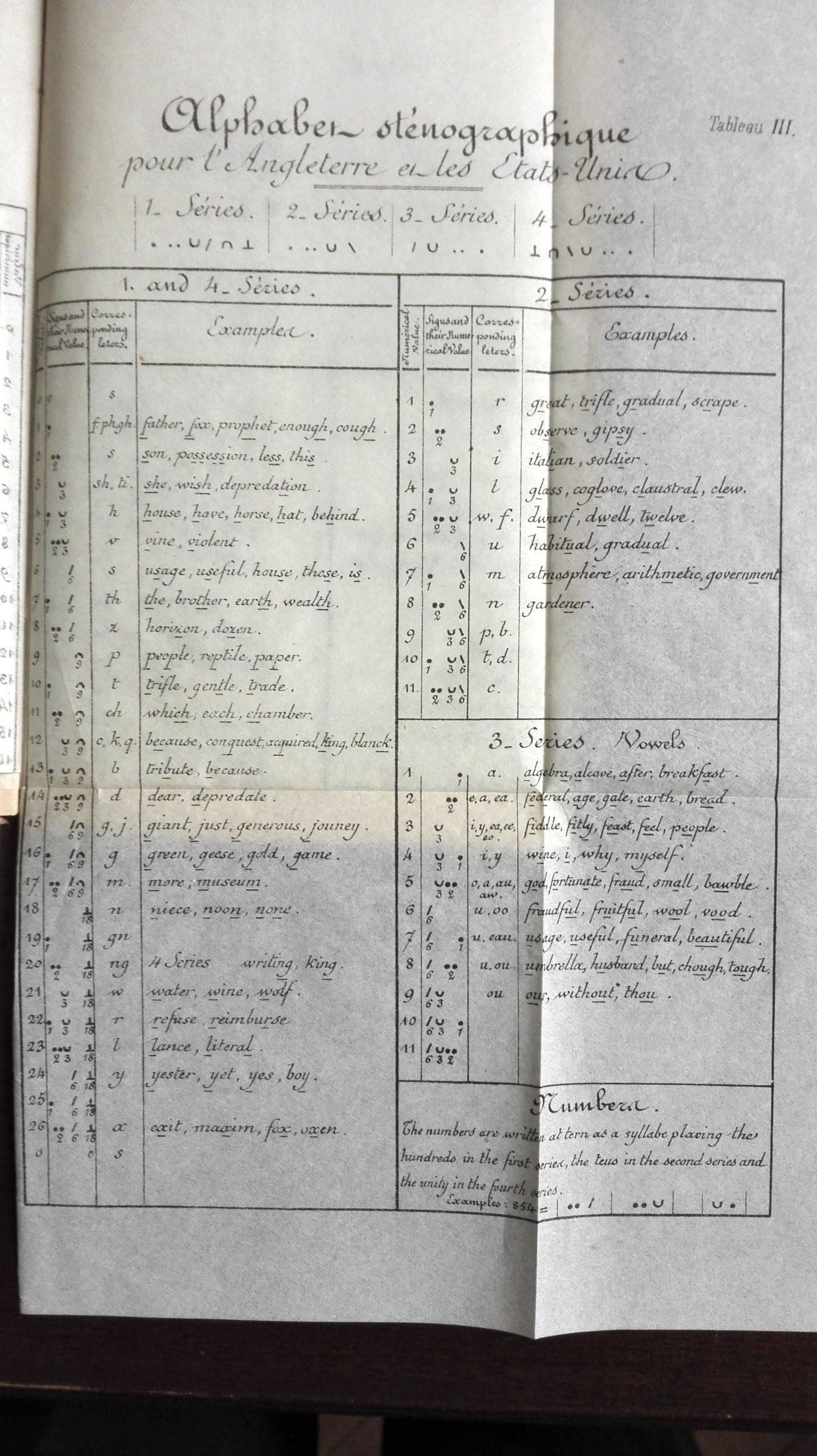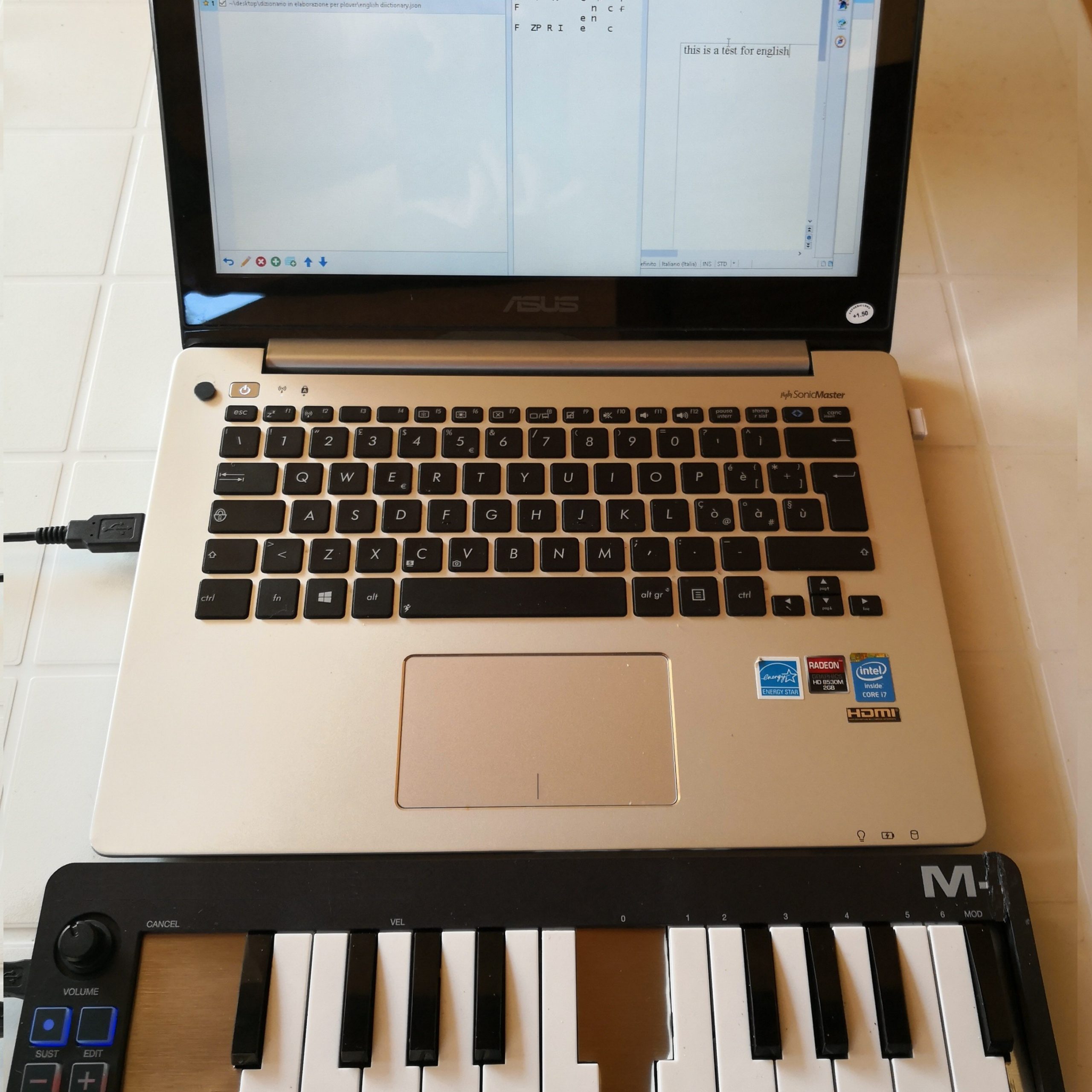Introduction
When Antonio Michela, the inventor of the famous Michela stenographic system, published his Manuel de la sténographie mécanique in 1882 it contained several illustrative tables, showing the application of his system to several languages including Italian, French, English and German. Publication of the manual was followed by numerous international demonstrations, which showed that the Michela system was highly efficient in graphically recording speech in multiple languages. Interest in international stenographic systems, based on Michela, continued during the early 20th century. The stenography teaching manuals published by the reporting office of the Italian Senate (e.g. De Alberti 1932), which had similar alphabetic tables for Latin, Russian and Spanish, serve to highlight this interest.

Until recently, the Michela system’s application to languages other than Italian remained on paper only. However, the issue has become topical again in the 21st century, thanks to several recent projects developed within the reporting office of the Italian Senate. In this article, we will provide a brief presentation of these recent projects: theories for using English and Arabic, and a system for writing music.
The English Theory
In 2017, following the decision by the Senate administration to aim to spread the knowledge of its stenographic keyboard to the public, the Michela keyboard and its Italian theory became connected to the Open Steno Project (see Casarola & Torregrossa 2020). Several people then made requests regarding the availability of Michela international theories, particularly for non-reporting uses in English. The main task of the Open Steno Project is, in fact, to promote the use of stenography outside its traditional field and so to enter text more efficiently for any task, such as writing texts, computer chats, vocalization systems for the disabled, and so on. To satisfy these requests we decided to create a Michela-English theory, starting from the original English alphabetic table designed by the inventor himself. This was headed “Alphabet sténographique pour l’Angleterre et les États-Unis” (and contained in the original manual cited above).

The main task was to develop a conflict-free theory containing no ambiguity in the meaning of the abbreviations used, as this can make the real-time translation uncertain and more difficult. This is done within all modern stenographic systems. The project’s first step was to include all sounds associated with long vowels in the traditional theory, similar to what modern theories had done within the US stenotype system. English spelling has two main categories of vowel: “short”, when consisting of a single vowel, and “long”, when consisting of a doubled vowel, a diphthong or a vowel whose sound is modified by another elsewhere. For instance, to avoid conflicts different keys are used to write a short A as in “cap” and a long A as in “cape” (see Loeblein Ritter 1991). To encode these sounds, some key combinations were taken from those used originally in Michela for several French, German and Italian sounds (OI, OUI, Ö, Ü, e mute Ø, È). Additionally, the values of some residual vowel-key combinations have been dedicated to a series of recurrent English diphthongs, such as ow and ou, and to differentiate possibly conflicting groups such as ea/ae and oa/oo effectively.
As for consonant sounds, by changing the values of some dedicated key combinations the graphemes w, y and j were introduced, as well as the most recurrent English-language grapheme groups. These are st, nt/n’t, rt/rd, and the end sounds “shun” and “kshun”(for -tion and -ction word endings). In the Michela layout, some groups of consonant sounds and inflected endings could not be written in one stroke; they had to be rendered by means of an additional stroke, following the same principles as the earliest versions of the US StenEd theory (Loeblein Ritter 1991).
In some cases, it is possible to use abbreviations based on so-called inversions by writing one of the two ending consonants before the vowel. For example “bulb” can be written “blub”, or “park” can be written “prak”. Moreover, several combinations of two characters (not recurring in the English language) were used to represent English consonant blends found rather frequently at the beginning of words, as well as additional diphthongs (eg initial blends “str”, “spl”, “spr”, “scr”; middle diphthongs “aw”, “oy”).
Finally, as with the asterisk in the US stenotype keyboard, specific keys and combinations (U and RX) have been dedicated to differentiate strokes, as well as providing a syllabic finger-spelling system for words not included in the user’s main personal dictionary. The latter allowed all consonant-vowel-consonant (CVC) groups to be transcribed with a single stroke. The abbreviations theory was made using similar approaches to those in the US.
The Arabic Theory
When some officials from the Tunisian Assembly of People’s Representatives visited the Italian Senate in 2018, they were interested in conducting research on the Italian Senate’s reporting system. Following this, an experimental orthographic theory for Arabic was developed for illustrative purposes. The theory was developed in collaboration with Dr Fulvio Azzali.
Arabic has 27 consonants (without including the special silent consonant, alef). Since the Michela system has 26 consonant sounds it was necessary, using an unconventional key combination, to add a character corresponding to the sound kh (Arabic letter خ). Meanwhile, the 13 possible Michela vowel sounds were used to represent the three Arabic vowels a, i and u, categorized as short and long sounds and initial, middle and final characters. Being an orthographic system, combinations for final characters automatically include a space at the end of the word. Specific combinations have also been provided for alef madda (آ) and alef maqsūra (ى) characters. At the moment, several key combinations are not used, especially in the middle part of the keyboard. This is used mainly to write the long i and hamza sounds in their various positions (أ إ ئ ؤ).
Since the Arabic theory is a simplified system, no abbreviations are currently foreseen. However, they could easily be introduced if there was a demand for it.
The last frontier: Stenography and music
In 2018, the Italian Senate was invited by the Australia Council for the Arts to collaborate on realising the art project “Assembly”(Mesiti 2019), which highlights the importance of individuals coming together to foster democratic participation. The project, filmed in the Italian Senate’s assembly and in Canberra’s Old Parliament House, was made by the artist Angelica Mesiti and chosen to represent Australia at the 58th Venice Biennale in 2019.
The Michela keyboard’s layout comprises two octaves of a musical keyboard. This inspired Mesiti, whose artistic research covers the field of non-verbal communication. Mesiti used Michela’s stenographic symbols to write a musical score inspired by the concept of sounds as a universal alphabet, which is at the basis of the Michela system. In particular, the Michela keyboard was used to encode the poem To be Written in Another Tongue, by Australian writer David Malouf. Through the MIDI score recorded during stenoscription, the poem was subsequently transposed into music by composer Max Lyandvert, and ultimately performed by 40 performers using different instruments (Mesiti 2019).

The original Michela-English keys alphabet, illustrated in the aforementioned inventor’s manual, were chosen to transpose Malouf’s poem by respecting the original 19th-century machine’s iconic “sounds” for each combination (when played on a piano keyboard). This triggered the need to explore new terrains in the Michela system, such as the keyboard’s sounds from each steno-combination through recording the MIDI codes they produced, and their final transposition into a musical score.
Conclusion
The three projects described above show the great versatility of the Michela system and its potential applications when a practical experimental approach is adopted. These activities are ongoing. A theory for the Spanish language is in development which may be based on the Michela conflict-free theory for Italian, given the structural similarities of the two languages. The system’s potential in phonetic representation could make it possible to apply it to many other languages, pursuing its inventor’s dream to create a universal alphabet based on sounds.
Fabio Angeloni is a chief reporter and a Hansard managing editor in the Debates Services in the Italian Senate, Rome. Paolo A. Michela Zucco is a chief reporter, Hansard editor and shorthand instructor in the Debates Services in the Italian Senate, Rome.
References
Casarola D. & Torregrossa G. (2020). Italian shorthand machines in the open source era, in Tiro 1/2020. Retrieved from: https://tiro.intersteno.org/2020/05/italian-shorthand-machines-in-the-open-source-era/
De Alberti C. (1932). Manuale di stenografia Sistema «Michela»; seconda edizione. Roma: Tipografia Agostiniana
Loeblein Ritter B. (1991). Real-time machine shorthand for expanding careers – Basic theory Vol. 1 Melrose, Florida: Stenotype educational products – StenEd
Mesiti A. (2019). “Assembly”: artistic project commissioned by the Australia Council for the Australian pavilion, Venice Biennale. Retrieved from: https://nga.gov.au/mesiti/assembly/
Michela A. (1882). Manuel de la sténographie mécanique – Systéme Antoine Michela. Paris: Saint Germain Imprimerie D. Bardin et C.





[…] Fabio Angeloni & Paolo A. Michela-Zucco:Michela stenotype and the universal alphabet […]